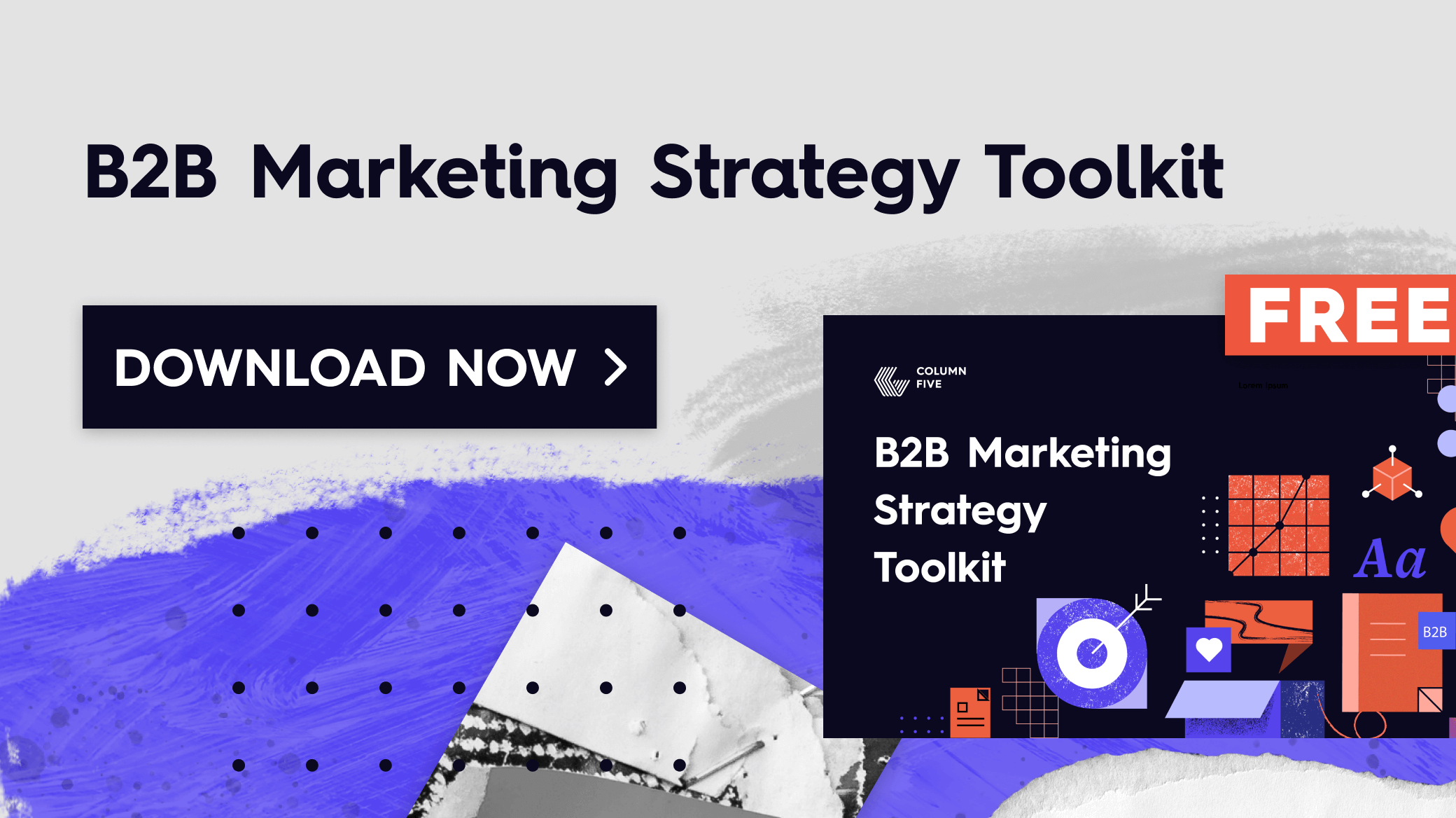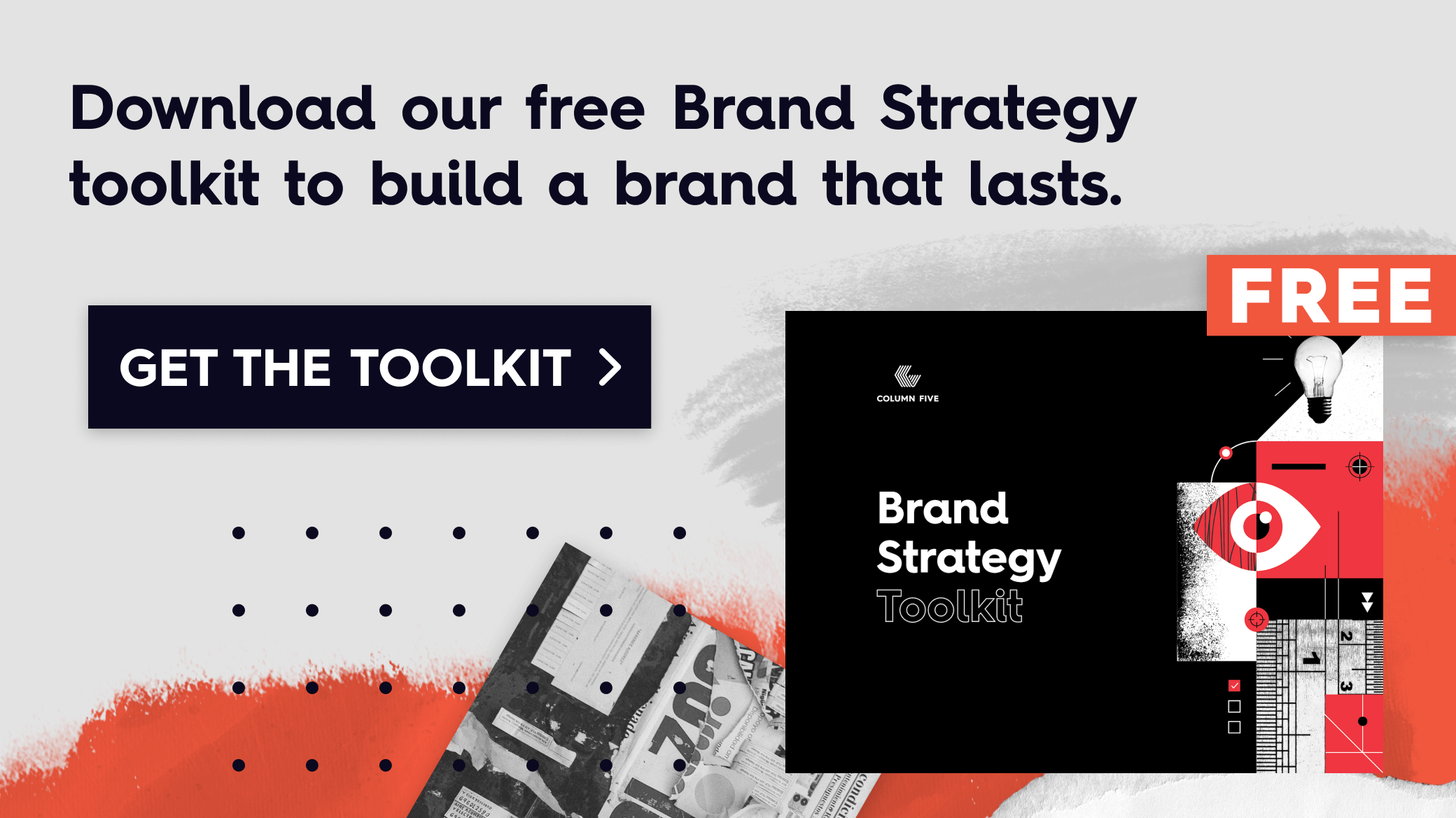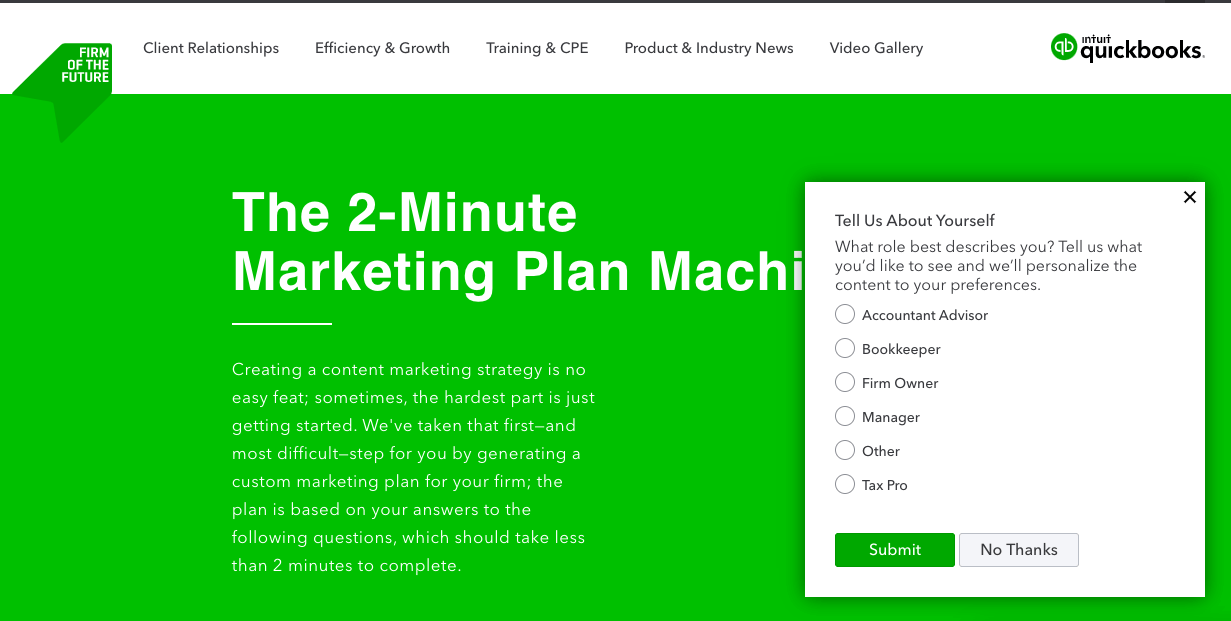So you’re creating a content marketing strategy for B2B lead generation, but you don’t know what type of content you should create. Will it be infographics? Ebooks? Videos? Should you curate a mix, or put all your eggs in one content basket? These are tough questions (and some of the most common we hear from our clients).
Unfortunately, there is no one-size-fits-all approach to content marketing. The “right” content depends on your brand’s unique goals, your audience, and other factors. But you do need to understand the variety of content you can make, what each content type is particularly good for, and what it takes to actually produce it. Luckily, you’ve come to the right place.
We know firsthand that the world of content marketing can be overwhelming. In fact, we’ve spent more than a decade navigating this wilderness, making mistakes, and learning exactly how to make content marketing that actually works.
So, to make your life easier (and save you a decade’s worth of learning), we’ve compiled this thorough breakdown of the different types of B2B lead generation content, as well as tips to make each type work for you. From visual content to thought leadership, it’s everything you need to know to create the best content marketing for your brand.
But, before we dive in, there are a few things to keep in mind.

What to Know Before You Start Brainstorming
Too many brands dive into B2B content marketing blindly, with a lot of enthusiasm but much less foresight. Soon, they suffer a range of pesky problems.
- They underestimate the amount of time, money, or infrastructure it takes to create content, leading to an out-of-control scope increase.
- They push back deadlines endlessly, and thus they don’t publish content with any steady cadence.
- They spend a lot on content that doesn’t resonate with their audience, so their content is ineffective.
- They don’t accurately measure how their content performs, so they continue to work blindly.
After all this, they don’t have much to show for their efforts (except a lot of frustration and a disheartened team). That is why we emphasize the importance of three key things to anyone launching or retooling their marketing operation.
1) Document your strategy.
According to the Content Marketing Institute, only 40% of marketers have a documented content strategy. If you want to be successful, you need to do a lot of legwork before you schedule your first content brainstorm.
- You need to know your own goals and have them clearly documented.
- You need to know who your audience is, what interests them, and how your brand fits into their story.
- You need a concrete way to measure those goals, quantify your success, and improve with each campaign.
- You need to know what current content is and isn’t working.
- You need a solid distribution plan to help your content reach your audience.
Without these foundational elements, you can’t ensure that your content is aligned to your goals and primed to succeed. If any of your strategy needs work, use our free Content Strategy toolkit to guide you through the process.
2) Have the right knowledge (or know what you don’t know).
Different content requires different expertise. Whereas an article can be written by one person, something ambitious like a data-heavy interactive requires multiple departments (e.g., web development, design, etc.). Unless you’re working for a huge brand with an in-house creative team at your disposal, it’s likely that your team may have some knowledge gaps that can cause serious problems down the road. (We’ve personally seen too many brands get in over their head and thus produce work that is seriously subpar.)
When you want to demonstrate your expertise and credibility to your audience, creating low-quality work will only damage your brand perception. Thus, it’s important to know what your team is genuinely capable of producing to ensure you can estimate time and cost appropriately, provide the right tools and resources, or bring in the right help (whether that’s a freelancer or agency).
50% of B2B marketers outsource content.
—Content Marketing Institute 2022 B2B Content Marketing Report
3) Curate the right mix of content.
Content marketing is like a healthy diet. You need to serve a variety of content to keep your audience nourished (aka interested and engaged). This is why measuring your content’s success is so important. The better you can identify what resonates with your audience, the better you can tailor your mix to serve them (and save you unnecessary work). For more on this, find out how to curate the right mix for your strategy.

Now let’s dive into the wonderful world of content you can explore.
How to Choose the Right Content for B2B Lead Generation
Here, we’ve broken down the different types of content you can use for B2B lead generation, their level of difficulty, and our best tips to help you create them. Naturally, different formats are better suited for certain goals. Thus, your brand’s content mix should be curated based on what you’re trying to achieve.
1) Articles
Good for:
- SEO
- Establishing expertise
- Building brand awareness
- Expanding reach (via industry publications)
- Building a reputation in your industry
Level of difficulty: Low
Articles are one of the most popular forms of marketing, especially when trying to rank for topics related to your brand. They can be evergreen (e.g., an “ultimate guide” to something), they can be thought leadership, or they can be about trending topics.
They are simply a great way to share your expertise, start conversations, offer valuable advice, and discuss just about anything with your audience. They are also less expensive, take less time to produce, and require fewer stakeholders than a larger, more elaborate piece of content. And because they require less oversight, you can create a higher volume to see what gains traction.
Whether you’re publishing on your own blog or contributing to a publication, articles can be the meat-and-potatoes of your brand’s marketing mix.
Tips to create good articles:
- Do SEO the right way. Start by choosing the right keywords.
- Join the conversation. Writing about trending topics is a great way to join the conversation, but first you should understand how to newsjack without being a jackass.
- Choose relevant topics. Ask yourself these 5 questions to make sure your article idea will resonate with your audience.
Even if you don’t have a ton of “writers” on your team, there are plenty of people who can brainstorm good ideas or provide great material. Consider interviewing experts on your team for thought leadership, turning your team’s best tips into a helpful roundup, or publishing a Q&A with interesting people in your company or industry. (Learn more about how to turn your team into content creators.)
90% of B2B marketers short articles/posts for content marketing purposes.
—Content Marketing Institute 2022 B2B Content Marketing Report
2) Case studies.
Good for:
- Deep funnel
- Demonstrating results
Level of difficulty: Low
Case studies are a popular sales tool, allowing you to demonstrate your value, showcase your work, and (ideally) convince people to buy from you. Of course, not all case studies are created equal. The best case studies pique the reader’s interest, keep them engaged, and leave them inspired/ready to take action.
Tips to make good case studies:
- Tell a good story. Craft a strong narrative that infuses your brand into your customer’s story (communicating what you do/your value), and demonstrate that via results.
- Make it relatable. Your product/service solves a specific problem. Show real-world results that are relatable to your audience.
- Templatize your case studies so that you can easily create them. However, don’t make them feel completely generic or copy/paste. Create a flexible template that allows you to tell each story in an impactful way (think words/visuals).
- Keep them in one place. Make sure your team knows where they live and how to access them.
Find out more about how to create sales content to support your team.
Example: Instead of just curating a bunch of images of our work, we take an intentional approach to our case studies, telling the story of the client’s need, our creative approach, and the results we achieved together.
3) Data Storytelling
Good for:
- Communicating insights
- Thought leadership
- Building credibility
Level of difficulty: Medium (depending on how data literate you are)
In a world where there is so much information is suspect, people are desperate for sources of truth they can actually trust. (The same goes for journalists who are always looking for newsworthy content.) This is where data storytelling really shines.
By telling stories around data, finding stories in data, and sharing these insights with your audience and industry, you can provide a valuable service, create unique and engaging content, and build a strong and reliable reputation. Best of all, telling stories based on your own data can give you a competitive edge, helping you raise your profile and truly stand out.
Note: Understanding how to find the stories in your data will help you improve your marketing machine as well. The better you can understand what your data is telling you, the easier it is to extract helpful insights and make better decisions based on those insights.
Tips to create good data storytelling:
- Use reliable data sources. Try these 100+ free data sources, or look at your internal data sources.
- Find the story. Look for ways to put data storytelling to work at every level of your organization, whether it’s marketing content, internal reports, or sales presentations. You can start with our guide to dig into your data and find the unique and interesting stories within.
- Design your data the right way. Find out how to correctly choose and design the right visualization for your data.
- Reach out to publications. Data-based insights can be especially compelling for publications. Use our tips to reach out to publications and collaborate on content.
Find out more about why data storytelling is marketing gold.
Example: Incapsula surveyed 300 companies about their SAAS site availability, then turned that research into an animated infographic that offered readers a state-of-the-industry look at the issue. This type of data storytelling is the perfect way to speak to a niche audience and provide a new perspective.

4) Ebooks & Guides
Good for:
- Thought leadership
- Tutorials
- Exploring a topic in greater detail
- Building an audience
Level of difficulty: Medium (requires copywriting, subject matter expert, and design)
Ebooks and guides are one of the most popular lead-generating tools because they provide so much value to an audience. Whether someone is looking for a step-by-step tutorial or wants a deep dive into a specific subject, ebooks are a great way to give your audience that much-needed information. Also, because ebooks are often rich and/or data-heavy content, people spend more time engaging with the content. The more time they spend, the more they will view your brand as a trusted resource they can turn to again and again.
That said, ebooks do require more time to create (both in gathering content and designing it), but they have a great shelflife, especially if they cover evergreen topics. (Guides we’ve written years ago are still some of our most popular content.)
Note: There is a debate about whether you should gate ebooks or not. Ultimately, it depends on your marketing strategy. In general, for top-funnel topics where a larger, less-qualified audience is likely to be interested, we recommend you ungate the asset and keep your “contact us” or “request a demo” CTAs visible for when the reader is ready. (This also allows you to lead to deeper-funnel content.)
If you’re using ebooks for deep-funnel content (“How to XYZ”), it’s worth gating because you can presume it’s a higher-quality lead.
Tips to create good ebooks:
- Work smarter. See our step-by-step guide to create an ebook from start to finish. To optimize the creation process, use these 100+ tools and resources to create good ebooks.
- Prioritize design. Even if you’re not writing about the most sexy topic (here’s looking at you, B2B tech companies), there are plenty of ways to make your ebook designs more exciting.
If you’re stuck on inspiration, see how these brands have created excellent ebooks to engage their audiences.
Example: Our How to Create a Brand Strategy guide is one of the most successful pieces of content we’ve ever created. Not only did this rich content help us rank on page 1 of Google (for the keyword “brand strategy”) but the accompanying toolkit provides a practical tool to help our audience put our guide to work.

5) Email Content
Good for:
- Newsletters, thought leadership, drip campaigns
- Relationship-building/nurturing
- Distributing fresh content
Level of difficulty: Low
Emails are one of the best ways to build and grow your relationships with your audience. By keeping a steady stream of useful content in their inbox, you can stay top of mind, be a helpful resource, and keep the conversation going. Best of all, it allows for deep segmentation, ensuring you’re targeting people with the most relevant content.
Tips to create good email content:
- Nail your subject line. See Hubspot’s handy guide to craft copy that makes people click.
- Be succinct. Nobody wants to read an email the length of a tax law book.
- Add visuals. Visuals are a great way to break up text, capture attention, and keep people engaged.
For more, see Mailchimp’s best tips to make the most of email campaigns.
6) Infographics
Good for:
- Communicating information quickly and efficiently
- Sharing data
- Breaking down a process or steps
- Building brand awareness (via shareability)
Level of difficulty: Low to medium (requires copy and design)
We earned our stripes in the world of infographics (heck, we even wrote a book about them), so we know how powerful this type of content can be. Why are infographics so useful? Because they are inherently visual, letting you communicate information quickly and efficiently. They are also are highly shareable, helping you extend your reach across social platforms. (Media publications love to publish infographics as well, which is a great way to reach your target audience.)
Best of all, they are very versatile. Whether you’re sharing highlights from a new report, providing a visual tutorial, or showcasing product features, infographics are a handy tool to help tell your story in a compelling and attention-grabbing way at every stage of the buyer journey.
Note: Whatever you do, don’t gate them!
Tips to create good infographics:
- Build a narrative. Use credible data sources, and find out how to structure your infographic as an interesting story.
- Make them visual. Infographics must include a visual element. Learn the difference between data visualization, information design, and infographic design to understand how different formats can help you tell your story more effectively. You can also try these different infographic design styles for visual variety. If you’re not sure what design style you want to try, get inspired by these great examples of infographic marketing.
- Follow best practices to create quality infographics at scale. Start with our step-by-step guide to streamline your infographic creation process.
- Distribute them effectively. Find out how to optimize your infographics to get the most traffic.
Note: Even if you don’t have a large team, you can still design minimal infographics that make a big impact.
Example: Free the CIO by Lucidworks shares data insights about the challenges Chief Information Officers face. Whereas this information could be presented in an article, visualizing the data makes the content eye-catching and easier to digest.

7) Interactives
Good for:
- Engagement
- Self-guided/immersive storytelling
- Data storytelling with a large amount of data
- Increasing time on site
Level of difficulty: High (requires design and web development knowledge)
Interactives are one of the most exciting types of content marketing, as they immerse the viewer in the story completely. Whether it’s a narrative experience (e.g., an interactive slideshow that the viewer is guided through) or an exploratory experience (e.g., a large data visualization that they can filter and explore on their own), interactives are unique because they put the viewer in the driver’s seat.
Interactivity can also be used across the buyer journey, whether you’re looking to entertain, inspire, or educate your audience. They can be fun/lighthearted (e.g., a “What Marketing Superhero Are You?” quiz), a practical tool (e.g., ROI calculator), or a piece of sales collateral (e.g., interactive product demo). No matter the application, they are one of the most exciting forms of visual content.
Note: You can introduce interactivity into all sorts of content, including annual reports, ebooks, presentations, etc.
Tips to create good interactives:
- Follow best practices. Find out about the keys to a good interactive.
- Choose the right idea. Not every idea is right for an interactive. Use these questions to brainstorm (and vet) your ideas. And follow our tips to get the right eyes on your interactives.
- Make sure you have the right team. Interactives take a high level of knowledge and skill to execute, so you need true pros on the project.
- Use good design. Interactives can take many shapes and forms, as these 100+ interactive examples prove.
Example: To help small accounting firms better market themselves, Intuit created The 2-Minute Marketing Plan Machine, an interactive that generates a customized marketing plan based on the user’s unique needs.

8) Video (Motion Graphics, Live-Action, Explainer)
Good for:
- Video-centric social platforms
- Homepage hero video
- Tutorials and demos
- Communicating information quickly and effectively
- Increasing reach/engagement on social
Video is a powerful medium because it combines two modes of processing (our visual and audio channels). This makes it easier for the viewer to consume and synthesize the information presented. (There’s a reason why most people would rather watch a video than read a long pamphlet.)
This makes video an ideal medium for telling a brand story in a short amount of time (e.g., a 60-second explainer video). Best of all, you control the narrative entirely—unlike written content, which can be skimmed, or interactive content, which is user-controlled.
Now that more and more platforms are becoming video-friendly (or video-exclusive), brand video is becoming mandatory. Luckily, the methods of production are becoming more accessible to even non-creators. Whether you want to create a quick TikTok video on your phone, a full-quality live-action video, or a motion graphic (aka animated video), video allows for endless storytelling opportunities.
Note: Because video does tend to be on the more expensive side, you want to make sure it works for a key part of your buyer journey.
Level of difficulty: Medium to high (depending on the type of video)
Tips to create good videos:
- Write a strong script. What ends up on screen starts with the word on the page. Follow our best tips to craft a good video script.
- Find the right partner. Video is one of the most exciting mediums—and one of the easiest to mess up if you don’t know what you’re doing. Sound, color, lighting, and a million other things can affect the final product (and seriously degrade your brand if it’s not done correctly). If you are looking to do a higher-quality production, see our tips to find the right video agency and work with them effectively.
- Get creative. Even if you’re shooting remotely, you can still create high-quality video marketing. Get inspired by how these B2B brands have used clever videos to tell their brand stories.
For more tips on everything from scriptwriting to set etiquette, download our free e-book, the Content Marketer’s Guide to Brand Video.
Example: To promote their new VoiceAI platform, Dialpad released a humorous video that featured robots auditioning to voice the platform. This was a lighthearted way to highlight the new feature and give their audience a laugh—a much better way to start a conversation than a boring sales pitch.
9) Podcasts
Good for:
- Demonstrating expertise
- Growing a community
- Establishing credibility
Level of difficulty: Medium (more resources required)
Podcasts have exploded in the last decade, and they are only continuing to grow. Brands can provide a lot of value through this medium—as long as the topics they choose are relevant to their audience. Podcasts that educate, entertain, or inspire (or, miraculously, do all three) are most successful.
However, while you may think producing them is as easy as hitting record on your iPhone, because podcasts are not novel anymore, people expect a level of production quality. That means you need to have the capability to record, edit, and distribute effectively. Most importantly, you need the time and resources to sustain your podcasting schedule (that means choosing topics, booking guests, etc.).
Tips to create a good podcast:
- Be consistent. This is one of the most common mistakes in podcasting. You can’t post whenever you feel like it. You need to establish your cadence up front, whether you’re doing a season at a time or a weekly podcast indefinitely.
- Keep run time in mind. People are busy. Don’t use it as your personal open mic. Instead, know your topics, do your research, and keep it tight.
- Know your structure. Is this a scripted narrative podcast, an interview format, a loose conversation? Whatever it is, you will want to stay consistent.
Get more dos and don’ts of podcasting.
Example: To promo their SAP Leonardo technology, SAP created Searching for Salai, a 9-part sci-fi narrative podcast that combined time travel, history, and mystery into a suspenseful tale. (Who doesn’t love time travel?) It was an unusual and unique way to talk about technology—and it even won the Content Marketing Institute’s 2019 Content Marketing Project of the Year award.
10) Presentations
Good for:
- Sharing highlights quickly
- Saving time (for often-repeated pitches)
- Repurposing (into additional content)
Level of difficulty: Low to medium (depending on design requirements)
For a one-off or recurring pitch, a good presentation deck can help communicate key info easily and effectively. Presentations can also be used to delve into juicy thought leadership topics that help your company position itself in the industry (e.g., a hero presentation about the CEO’s vision for the industry).
Best of all, presentations can be repurposed across platforms. You might create a Slideshare deck of highlights, extract a few slides to create an Instagram carousel, or use a chart from your presentation to enhance your latest article.
Tips to create a good presentation:
- Keep it short. It’s a presentation, not a book, so trim it down to only the most compelling content.
- Tell a story. Your presentation should have a cohesive narrative. If someone is clicking through on their own, can they understand the core story?
- Add visuals. Visual content helps grab attention and keep viewers engaged. Just make sure to avoid the more common visual content design mistakes.
See more tips to create an engaging presentation.
11) White Papers & Reports
Good for:
- Data storytelling
- Industry insights
- Newsworthy content
- Establishing expertise
- Building credibility
Level of difficulty: High (requires a lot of research)
White papers and reports are incredibly valuable marketing content, allowing you to take an authoritative stance on topics (e.g. “State of Beekeeping”). By doing thorough and proper research, and condensing that research into interesting and eye-opening insights, you are doing a tremendous service to your audience, your peers, and your industry. In fact, of all the content marketing you can create, this type of research is often the most desired by journalists and other media outlets in your industry (as previously mentioned, good data is the secret to establishing your credibility).
You can also get a tremendous amount of mileage out of white papers and reports. For example, you might create an infographic highlighting the most interesting data insights, or elaborate on the findings in a series of articles. Those pieces of content can be used to promote the original piece, creating a perfectly symbiotic content ecosystem. (We call this a divisible content strategy.) Sometimes you can get a year’s worth of conversation from just one report.
Note: You should always gate your whitepapers and reports.
Tips to create a good white paper or report.
- Use accurate, clean data. Enough said.
- Extract and summarize the most relevant insights. If you’re not sure how to do that, here’s how to find the interesting patterns in your data.
- Use good design. No one wants to sift through a wall of text. Use imagery and data visualizations to make your report more digestible.
See more report design and storytelling tips to make sure your content is as engaging as possible.
Example: LinkedIn’s monthly Workforce Report is the perfect example of effective data storytelling. With access to millions of data points, the insights from this monthly report are an invaluable resource to the public, journalists, lawmakers, and more.
12) Social Media Content
Good for:
- Building brand awareness
- Sharing your employer brand
- Establishing credibility
Level of difficulty: Low
Social media content (also called Microcontent) is a great way to capture attention, engage your audience, and feed them a steady stream of interesting content across social channels. This helps you build a strong relationship with relevant audiences, who will eventually be more receptive to targeted sales pitches and paid media campaigns.
Having a steady social presence is also important to establish credibility. When prospects are doing self-guided research, they will want to see an active account with a good following and solid engagement.
Tips for creating social media content:
- Involve your audience. User-generated content is a great way to engage with people.
- Create teasers. Use microcontent to promote your larger pieces of cornerstone content (ebooks, reports, infographics, etc.) across channels.
- Share your culture. Showing people the people behind your brand is a great way to create more human connections. Get inspired by these ideas to show off your culture on social media.
- Measure the success of your social content. See our guide to choose the right metrics for your social media marketing.
For more tips, download our free guide to maximize your publishing with microcontent.
Example: Dropbox publishes a range of social media content, from tips, to customer spotlights, to culture marketing. This steady stream of bite-size content keeps the brand front of mind.
View this post on Instagram
13) Webinars and Online Courses
Good for:
- Engagement
- Thought leadership
Level of difficulty: Medium
If you want to engage with a more committed audience, webinars and online courses are a great way to do it. By diving into a specific subject, you attract an audience with a clear need that you can uniquely serve. (If charging is appropriate, these courses can also be an additional revenue stream.)
Beyond demonstrating your expertise, these offerings also allow you to interact directly with your audience via Q&As, follow-up conversations, etc. This helps you build a relationship that lasts long after the webinar wraps.
Tips for creating good webinars and courses:
- Repurpose your content. You don’t necessarily have to build a course from scratch. If you’ve published a lot of content on a particular topic, you can probably look at your content as a whole and then break it into individual lessons.
- Provide supplemental material. Templates, checklists, and other supplemental material gives them something tangible to take away and helps them better apply the lessons you’re teaching. Not only will they appreciate the resource but they will remember the awesome brand that provided it.
- Build a campaign around your webinar or course. Just as you can repurpose existing content into a course, you can also promote the course by sharing teaser material in the form of infographics, tips, social media content, etc. (Don’t forget to use appropriate social tags.) This is a great way to target different audiences across platforms and expand your reach.
- Ask for feedback. You want your courses to provide value and serve your audience’s needs. Poll your audience to find out what worked and what didn’t.
For more tips, see Hubspot’s guide to host a webinar.
Example: Hubspot hosts a variety of webinars with thought leaders across industries, allowing people to access their knowledge from anywhere in the world.
How to Ensure Your B2B Lead Generation Content Makes an Impact
No matter what content you choose to include in your mix, there are a few ways to ensure it resonates with your audience and works the way you want it to.
- Focus on value. We’ve said it a few times, and we’ll say it a million more. When you’re coming up with ideas, keep your audience’s needs in mind. If you can’t identify why your audience would be interested in the idea, it’s a no-go.
- Plan ahead. To publish with a consistent cadence, you need to schedule projects and allocate resources ahead of time. (This is yet another benefit of a content strategy.) Use our free template to write a content plan, and find out how to optimize your content creation process to work as effectively as possible.
- Use a divisible content strategy. The content you create can be used in many ways. If you’re putting the time and energy into content, you want to get the most mileage possible. Find out how a divisible content strategy can help you turn ebooks into infographics and infographics into social content.
- Apply your brand. Your unique brand identity is what makes you stand out from your competitors. How you look, how you talk, how you interact—it all reflects who you are. To tell a cohesive brand story, make sure every piece of content actually reflects your brand.
Of course, we know that even the best marketing teams need a little support now and then. If you’re on the hunt for content help, you can start your search here. Find out what to look for in an agency, learn more about what it’s like to work with us on your content strategy, or reach out directly. We’d love to help you create the content you need to reach the audience you want.






Hi
Author
Thank you for writing this amazing article.
I have read your article “13 Best Types of Content Marketing for B2B Lead Generation” and I found that you have covered a huge gap in the field of “Content Marketing”. This informative article will significantly contribute in this niche. I want to mention here that I have blog on the same niche http://www.tribunefox.com. I frequently write blogs for “Content Marketing”. I would love if you visit my blog and give value to my work.
Thank you and looking forward. 🙂